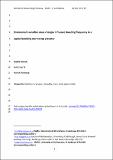Environment-sensitive mass changes influence breeding in a capital breeding marine top predator
Abstract
1. The trade‐off between survival and reproduction in resource‐limited iteroparous animals can result in some individuals missing some breeding opportunities. In practice, even with the best observation regimes, deciding whether ‘missed’ years represent real pauses in breeding or failures to detect breeding can be difficult, posing problems for the estimation of individual reproductive output and overall population fecundity. 2. We corrected fecundity estimates by determining whether breeding had occurred in skipped years, using long‐term capture–recapture observation datasets with parallel longitudinal mass measurements, based on informative underlying relationships between individuals’ mass, breeding status and environmental drivers in a capital breeding phocid, the grey seal. 3. Bayesian modelling considered interacting processes jointly: temporal changes in a phenotypic covariate (mass); relationship of mass to breeding probability; effects of maternal breeding state and mark type on resighting. Full reproductive histories were imputed, with the status of unobserved animals estimated as breeding or non‐breeding, accounting for local environmental variation. Overall fecundity was then derived for Scottish breeding colonies with contrasting pup production trends. 4. Maternal mass affected breeding likelihood. Mothers with low body mass at the end of breeding were less likely to bear a pup the following year. Successive breeding episodes incurred a cost in reduced body mass which was more pronounced for North Rona, Outer Hebrides (NR) mothers. Skipping breeding increased subsequent pupping probability substantially for low mass females. Poor environmental conditions were associated with declines in breeding probability at both colonies. Seal mass gain between breeding seasons was (a) negatively associated with lagged North Atlantic Oscillation for seals at NR and (b) positively associated with an index of seal prey (Ammodytes spp) abundance at Isle of May, Firth of Forth (IM). Overall fecundity was marginally greater at IM (increasing/stable pup production) than at NR (decreasing). No effects of mass were detected on maternal survival. 5. Skipping breeding in female grey seals appears to be an individual mass‐dependent constraint moderated by previous reproductive output and local environmental conditions. Different demographic trends at breeding colonies were consistent with the fecundities estimated using this method, which is general and adaptable to other situations.
Citation
Smout , S C , King , R & Pomeroy , P 2019 , ' Environment-sensitive mass changes influence breeding in a capital breeding marine top predator ' , Journal of Animal Ecology , vol. Early View . https://doi.org/10.1111/1365-2656.13128
Publication
Journal of Animal Ecology
Status
Peer reviewed
ISSN
0021-8790Type
Journal article
Description
UK Natural Environment Research Council funding to the Sea Mammal Research Unit enabled this work. NERC grant no. NE/G008930/1 and Esmée Fairbairn Foundation (PP). SCS was supported as a EPSRC postdoctoral fellow (RK, PP).Collections
Items in the St Andrews Research Repository are protected by copyright, with all rights reserved, unless otherwise indicated.

